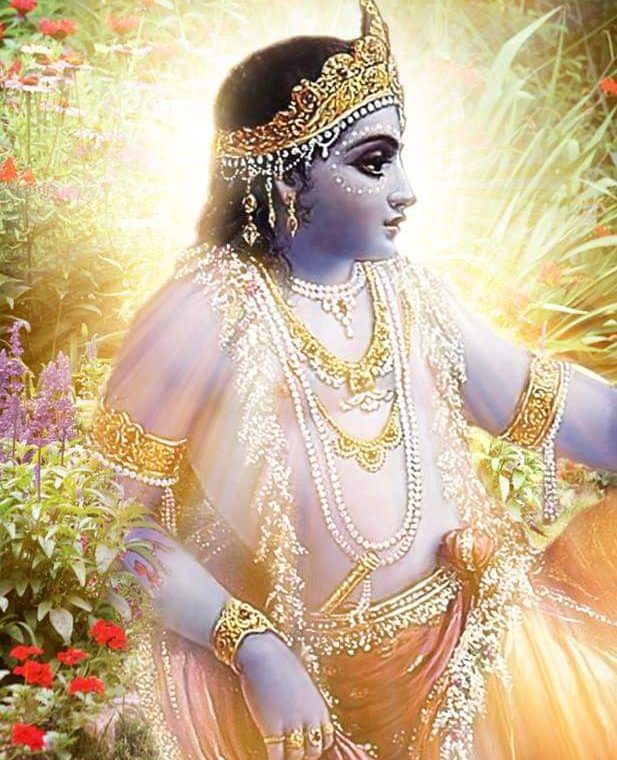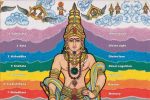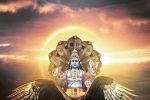NAME 62
Pavitram पवित्रम्
Pavitra means purity. Brahman is pure. Factually, Pure Consciousness is the Brahman and mundane level of consciousness is human. Everything in this universe is consciousness of different levels.
Kṛṣṇa says in Bhagavad Gita (IV.38), “There is no purifier like knowledge in this earth. One, who has purified his heart by persistent practice of karma yoga, automatically realizes the Self in course of time.” Internal purification happens only by aligning oneself with higher level of consciousness.
There can be another interpretation. Pavitra means purification of mind. As Realisation happens in the domain of the mind, one has to keep his mind devoid of any impressions. Subconscious mind is capable of storing impressions of past experience. Unless all the impressions in the subconscious mind are dissolved, one cannot realise the Self.
This nāma could mean, if one contemplates Lord Viṣṇu, He is realised as the Self. Pavitram means Purity Incarnate. One who gives purity to the heart. To the seekers who are meditating upon Him, He gives inner purity, and hence He is known as Pavitram. Or, the term Pavi means; the weapon Vajra (thunderbolt). One who saves (“tram”) his devotees from the thunderbolt of lndra is Pavitram. This can also be interpreted as the “Giridhara” episode where the lord saves his devotees from Indra’s wrath. The thunderbolt is described as an instrument made out of the bone of sage Dadhichi. Indra is the Lord of the lndriyas. In Vedanta Indra signifies the mind. Mind’s cross purposes, confusions, intellectual compromises and the consequent self- cancellation of our mental powers (Sankalpa-Vikalpa) can be the great thunderbolt of the mind with which Indra (mind) can destroy in no time all the acquired tapas of the Sadhaka. Deep devotion, ardent meditation and firm faith in the Lord Vishnu save the Sadhaka from all such mental storms and, therefore, the Lord acquires the significant name Pavitram. He is both Pure and makes His devotees Pure. The purity referred to here is the inner purity of the mind which He has and which He gives to those who meditate on Him. That is why the famous saying goes ‘Govindeti sadaa Snaanam, Govindeti Sadaa Japam – The mere mention of Govinda purifies like a bath. The mere thought of Govinda is like a sustained meditation’.
Both Sri Radhaakrshna Shastri and Swami ChinmayAnanda offer a second and more uncommon interpretation – One who gives protection (traayate) from the thunderbolt of Indra (pavi). Swami ChinmayAnanda points out that in Vedanta, Indra refers to the mind (Indriyanam raja Indrah – the mind), and the thunderbolt of mind can destroy all the accomplishments of a Sadhaka, and only uninterrupted meditation of Sri Vishnu can give the protection against such distractions, and thus Vishnu is Pavitra.
न हि ज्ञानेन सदृशं पवित्रमिह विद्यते |
तत्स्वयं योगसंसिद्ध: कालेनात्मनि विन्दति || 38||
Bhagavad Gita (IV.38)
na hi jñānena sadṛiśhaṁ pavitramiha vidyate
tatsvayaṁ yogasansiddhaḥ kālenātmani vindati
Translation
BG 4.38: In this world, there is nothing as purifying as divine knowledge. One who has attained purity of mind through prolonged practice of Yog, receives such knowledge within the heart, in due course of time.
Commentary
Knowledge has the power to purify, elevate, liberate, and unite a person with God. It is thus supremely sublime and pure. But a distinction needs to be made between two kinds of knowledge—theoretical information and practical realization.
There is one kind of knowledge that is acquired by reading the scriptures and hearing from the Guru. This theoretical information is insufficient by itself. It is just as if someone has memorized a cookbook but has never entered the kitchen. Such theoretical knowledge of cooking does not help in satiating one’s hunger. Similarly, one may acquire theoretical knowledge on the topics of the soul, God, Maya, karm, jñāna, and bhakti from the Guru, but that by itself does not make a person God-realized. When one practices sādhanā in accordance with the theory, it results in purification of the mind. Then, from within one gets realization of the nature of the self and its relationship with God. The Sage Patañjali states:
śhrutānumāna-prajñābhyām anya-viṣhayā viśheṣhārthatvāt (Yog Darśhan 1.49)[v36]
“The knowledge attained by realization from within through the practice of Yog is far superior to theoretical knowledge of the scriptures.” Such realized knowledge is being extolled by Shree Krishna as the purest sublime thing.
The Story of Parikshit – Lord Krishna demonstrates His Purity
On the last night of the war, after Duryodhana’s defeat, a very disturbed and restless Ashwatthama was sitting sleepless under a large tree. An Owl ambushing a group of Crows caught his attention. This gave him an idea of attacking the Pandavas’ camp at night. He gathered the other surviving Kaurava warriors—Kritavarma and Kripacharya and attacked the Pandava camp. He strangled Dhrishtadyumna to death in his sleep, beating and thrashing the semi-conscious warrior. He moved on and killed Shikhandi, Uttamaujas and many other prominent warriors of the Pandava army. Those who tried to flee from Ashwatthama’s wrath were hacked down by Kripacharyya and Kritavarma at the camp’s entrance. He killed Draupadi’s five sons, the Upapandavas, while they were sleeping, believing them to be the five Pandava brothers. Ashwatthama, realising his mistake, went to Sage Veda Vyasa’s ashram in order to seek salvation (prayaschittam) for his crime.
The Pandavas and Krishna returned to their camp the next morning and were incensed to learn about the cowardly act of Ashwatthama. The Pandavas went after him to Sage Vyasa’s ashram. Upon seeing the approaching Pandavas seething in anger, Ashwatthama (who learnt that he had killed the upapandavas and not the Pandavas) realised that he was trapped now. As a last resort, he used his sacred knowledge of the Vedas to devise a Bramha Astra from a blade of grass and invoked it against the Pandavas and Krishna, although he was strictly forbidden to do so by his father Dronacharya for any purpose whatsoever. On seeing the Brahma Astra approaching the Pandavas, Krishna asked Arjuna to invoke the same. Arjuna invokes Bramha Astra, which he received from Dronacharya towards Ashwatthama.
On seeing the two powerful Astras heading for a head on cataclysmic (catastrophic) collision that would result in the annihilation of the entire Earth, Sage Vyasa used his Yogic powers to stop the divine weapons from colliding with each other. He asked both these warriors to withdraw their respective weapons. Arjuna was able to withdraw his Brahma Astra, while Ashwatthama could not do so as Dronocharya did not teach his son how to withdraw it. Ahswathama was given the option of deviating his weapon towards one single isolated object in a place that was not inhabited by any form of life, so that the Brahma Astra does not harm anyone on Earth. But Ashwatthama, out of spite, directed the weapon towards the womb of Uttara (wife of Abhimanyu) who was carrying Abhimanyu’s son (Parikshit) in an attempt to end the lineage of the Pandavas.
Abhimanyu’s son was still born and Uttara pleads to Krishna to save the child. Shri Krishna says to Uttara –
‘O Uttara, I never utter an untruth. My words will prove true. I shall revive this child in the presence of all creatures. Never before have I uttered an untruth even in jest. Never have I turned back from battle. (By the merit of those acts) let this child revive! As righteousness is dear to me, (by the merit of that disposition of mine) let Abhimanyu’s son, who is born dead, revive! Never hath a misunderstanding arisen between me and my friend Vijaya (Arjuna). Let this dead child revive by that truth! As truth and righteousness are always established in me, let this dead child of Abhimanyu revive (by the merit of these)! As Kansa and Kesi have been righteously slain by me, let this child revive today by that truth!’
‘After these words were uttered by Vasudeva, that child, O’ foremost one of Bharata’s race, became animate and began gradually to move, O’ monarch.’ [Mahabharata]
Thus by reviving Parikshit, Krishna demonstrates his purity.
|६२. ॐ पवित्राय नमः |
62. OM Pavitrāya Namaḥ
Pavitram –One who gives purity to the heart. To the seekers who are meditating upon Him, He gives inner purity, He is both Pure and makes His devotees Pure and hence He is known as Pavitram.
Or, the term Pavi means; the weapon vajra (thunderbolt). One who saves (“tram”) his devotees from the thunderbolt of lndra is Pavitram. This can also be interpreted as the “giridhara” episode where the lord saves his devotees from Indra’s wrath.
The thunderbolt is described as an instrument made out of the bone of sage Dadheechi. Indra is the Lord of the lndriyas. In Vedanta Indra signifies the mind. Mind’s cross purposes, confusions, intellectual compromises and the consequent self- cancellation of our mental powers (Sankalpa-Vikalpa) can be the great thunderbolt of the mind with which Indra (mind) can destroy in no time all the acquired tapas of the saadhaka. Deep devotion, ardent meditation and firm faith in the Lord Vishnu save the saadhaka from all such mental storms and, therefore, the Lord acquires the significant name Pavitram
Yena punāti tat pavitram That by which one is purified. It can be an object/being or a Mantrā or R̥ṣi.
पिताहमस्य जगतो माता धाता पितामह: |
Bhagavad Gīta – Chapter 9, verse 17
वेद्यं पवित्रमोङ्कार ऋक्साम यजुरेव च || 17|
Pitā’hamasya jagato mātā dhātā pitāmahaḥ,
Vedyaṃ pavitra moṃkāra r̥ksāmayajureva ca. (17)
Of this world, I am the father, mother, ordainer and the grand father; I am the knowable, the sanctifier, the syllable OM as also R̥k, Sāma and Yajus.
INTERPRETATION GUIDED BY SANT VANI (WORDS OF SAINTS)
Pavitram
The one who purifies.
Pavitra is that which purifies. ‘Pū’ is the root and ‘itra’ is the suffix. Perhaps the word, ‘pure’ comes from the Sanskrit root.
He who is the purest of the pure. He is ‘purity incarnate’. He who gives the gift of “purity” to those devoted to him.
OR
He, who protects his devotees from Pavi (पवि), the thunderbolt of Indra – the king of the Devas.
The Supreme being is the purest of the pure. Purity is the very essence of his being and hence he is called Pavitram (पवित्रं). While, “He” can bestow on us the gift of ‘purity’ it is essential that we make ourselves ready to be able to receive it by purifying ourselves.
This we can do by slowly and through constant effort getting rid of all those Kleśas (literally poisons) that afflict our mind – in fact this is what is meant when it is said that “He” protects his devotees from the thunderbolt of Indra because Indra is the god of the senses and sometimes the senses can indeed run amok and then the effects and consequences are indeed like being struck by a thunderbolt.
PLEASE WATCH
The many Kleśas of the mind like anger, greed, envy, restlessness, laziness, sloth, pride and so on have to be necessarily given up in order to slowly purify oneself. This begins with the yogic practices of Yamas and Niyamas that help place us on the right path and help rein-in and control the mind that races about like uncontrolled horses. Purity for most people must also include complete physical purity as well.
PLEASE WATCH
In our shastra, we don’t have the concept of a sinner at all. So called bad thoughts don’t make a bad person. In the Gita, Bhagavan refers to Arjuna as anagha, the one who is sinless, also a word to reveal the Atma. By whom a person gets free from all vrittis and vikaaras (tendencies of the mind) that is pavitra. By remembering whom or by worshipping and relating to whom, people are freed from chitt vrittis and vikaaras and become pavitra. By these pure actions, the person gains good karma. Īśvara is called Pavitra. What he is, is what he does!
The mantra that purifies you is also pavitra. Some scientific experiments suggest that the waters in which mantras are chanted have a different chemical composition as compared to waters where mantras are not chanted. The body composition largely being water, how much more effect will a mantra have on the person, if chanted correctly!
One who purifies, that is, a ṛṣi or a devatā can also be Pavitra. Here it is the devatā because we are talking about Īśvara. So, Lord Vishnu is called Pavitra.
PLEASE WATCH
How does the Lord purify? Does the thought purify or does Īśvara purify? The thought by itself does not do anything. The thought only comes and goes, but it is only Īśvara who purifies the intentions before thoughts turn into actions. It is the thought of Īśvara alone that purifies our intention, that frees us from the burden of desires and aversions. My desires and aversions contribute to the impurity of subjectivity because of which I can’t see what is. When I can’t see what is, about myself, my situations, people around me, I am not in touch with reality. The Lord is the means of purification and is hence called Pavitra.
PLEASE WATCH
One of the most famous Vachanas of Shri Basavanna talks about this purity and the way to achieving this:
“Kalabeda Kollabeda, Husiya nudiyalubeda,
Muniyabeda, Anyarige asahya padabeda,
Thanna bunnisabeda, Idira haliyalubeda,
Ide antharanga shuddhi, Ide bahiranga shuddhi,
Ide namma Kudalasangamana olisuva pari.”
Do not steal, do not kill,
do not lie, do not rage,
do not loathe the other,
do not brag of yourself,
do not revile the opponent.
This itself is inner purity,
this itself is outer purity.
This alone is the way to win
our Koodalasangamadeva
For those who are beginners on the path, it is not enough to quote the above and say that purity is only on the inside and it is OK to be as we please outside – Cleanliness and utmost care of the physical nature is also essential because the state of the body does have a bearing on the state of the mind and vice versa – the psyche and the soma are inseparably intertwined.
https://os.me/spiritual-purity-physical-mental-and-moral/
Sri Ramakrishna Paramahamsa used to give the example of a needle covered with dirt – A magnet cannot attract such a needle covered with dirt. However, if the needle were to be cleaned with the tears of pure devotion then the Magnet (God) will attract and draw the needle (devotee) to itself.
उम्र भर हम यही गलती करते रहे..
धूल चेहरे पे थी और आईना साफ करते रहे..! – Mirza Ghalib
How does one begin?
Start by taking the name of the Supreme Being – one of the methods that helps is mantra-japa – likitha (written) or maansik in utmost devotion and manana (metal contemplation). Kari Vichaar Tyaji Vikaar…only through constant mindfulness and contemplation on our mind, thoughts actions and speech can result in lasting self purification by dissolving in devotion to the Lord.
PLEASE WATCH
Lord Krishna said: My dear Uddhava, the unalloyed devotional service rendered to Me by My devotees brings Me under their control. I cannot be thus controlled by those engaged in mystic yoga, Sāṅkhya philosophy, pious work, Vedic study, austerity or renunciation. Only by practicing unalloyed devotional service with full faith in Me can one obtain Me, the Supreme Personality of Godhead. I am naturally dear to My devotees, who take Me as the only goal of their loving service. By engaging in such pure devotional service, even the dog-eaters can purify themselves from the contamination of their low birth. Neither religious activities endowed with honesty and mercy nor knowledge obtained with great penance can completely purify one’s consciousness if they are bereft of loving service to Me. If one’s hairs do not stand on end, how can the heart melt? And if the heart does not melt, how can tears of love flow from the eyes? If one does not cry in spiritual happiness, how can one render loving service to the Lord? And without such service, how can the consciousness be purified? A devotee whose speech is sometimes choked up, whose heart melts, who cries continually and sometimes laughs, who feels ashamed and cries out loudly and then dances, a devotee thus fixed in loving service to Me purifies the entire universe.
– Srimad Bhagavatam 11.14.20-24
Only when we turn our Uddhava Minds into Gopi Minds completely surrendering in Bhakti does the nectar of love and purity flows which is what Bhagwan is.
A good practice that has benefited many of us in the past is journaling and keeping a check on our Mind, Actions and Speech three times a day to review if our mind and actions are truly in alignment with our intentions.
This name is a nirantar deerghkaalen Sadhna to constantly reflect and review “What am I thinking? How am I feeling?”



